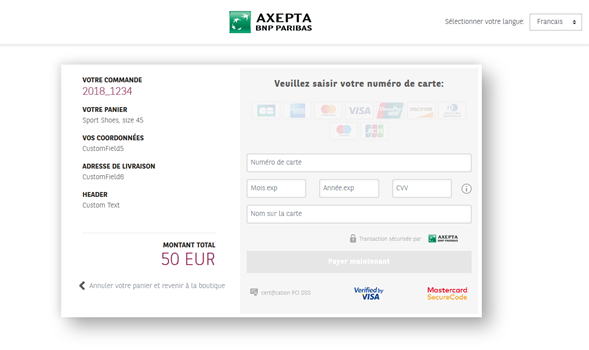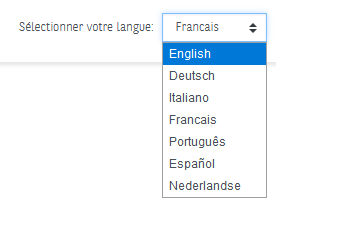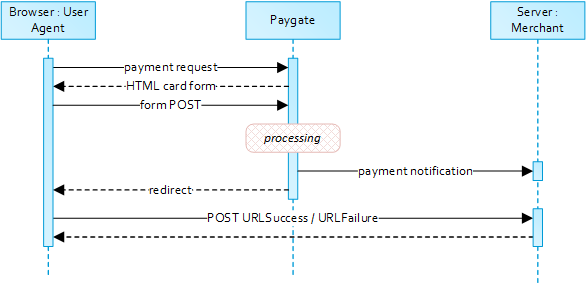Payment Request
To retrieve a card form please submit the following data elements via HTTP POST request method to :
The following table describes the encrypted payment request parameters:
Integration and customization options
To adapt the layout of the SSL-page to your shop you can use the following unencrypted parameters to configure :
| Key | Format | CND | Description |
|---|---|---|---|
| CustomField[n] | ans..50 | O | Field that can be used individually by the merchant. Presently 9 fields from CustomField1 to CustomField9 are supported. |
Template | ans..20 | O | Name of XSLT-file with your own layout for the pay form. If you want to use the redesigned and downwards compatible BNP template, please transfer the template name “ct_compatible”. If you want to use the responsive BNP template for mobile devices, please transfer the template name “ct_responsive”. → To modify |
Language | a2 (enum) | O | Language code of the merchant's payment page : <de> German, <en> English, <fr> French, <it> Italian, <pt> Portuguese,<es> Spanish, <nl> Dutch No details mean the language is French. |
All information related to integration ans customization options are available here : Checkout experiences and customization
On the customer side
will return an HTML document in the response body representing the requested card form. The form may be included in the merchant checkout page or used as a standalone page to redirect the cardholder to.
Cardholder authentication and payment authorization will take place once the the cardholder entered all required card details and submitted the form data to .
Note: In case you are using your own templates (Corporate Payment Page), please make sure you include Cardholder name on your custom template. Cardholder name is mapped to API parameter "CreditCardHolder". Cardholder name field must not contain any special characters and must have minimal length of 2 characters and maximum length of 45 characters.
Response - HTTP POST to URLSuccess / URLFailure / URLNotify
When the payment is completed will send a notification to the merchant server (i.e. URLNotify) and redirect the browser to the URLSuccess resepctively to the URLFailure.
The blowfish encrypted data elements as listed in the following table are transferred via HTTP POST request method to the URLNotify and URLSuccess/URLFailure.
The following table describes the payment response parameters :
The following table gives the result parameters which Axepta Platform transmits to URLSuccess or URLFailure and URLNotify. If you have specified the Response=encrypt parameter, the following parameters are sent Blowfish encrypted to your system:
pls. be prepared to receive additional parameters at any time and do not check the order of parameters
the key (e.g. MerchantId, RefNr) should not be checked case-sentive
ans..30 | M | MerchantID, assigned by BNP | |
RefNr | an12 | M | Merchant’s unique reference number, which serves as payout reference in the acquirer EPA file. Please note, without the own shop reference delivery you cannot read out the EPA transaction and regarding the additional settlement file we cannot add the additional payment data. Notes:
|
| PayID | an32 | M | ID assigned by Platform for the payment, e.g. for referencing in batch files as well as for capture or credit request. |
| XID | an32 | M | ID for all single transactions (authorisation, capture, credit note) for one payment assigned by Platform |
| Code | an8 | M | Error code according to Platform Response Codes (A4 Error codes) |
| Description | ans..1024 | M | Further details in the event that payment is rejected. Please do not use the Description but the Code parameter for the transaction status analysis! |
TransID | ans..64 | M | TransactionID which should be unique for each payment Please note for some connections the different formats that are given within the specific parameters. |
Status | a..50 | M | OK or AUTHORIZED (URLSuccess) as well as FAILED (URLFailure) |
an64 | M | Hash Message Authentication Code (HMAC) with SHA-256 algorithm. Details can be found here: HashMAC-Authentication. | |
| UserData | ans..1024 | O | If specified at request, Platform forwards the parameter with the payment result to the shop. |
MaskedPan | an..19 | OC | Masked card number 6X4. If you want to receive the parameter MaskedPan, please contact Axepta Helpdesk, which can activate the return. |
TransID | ans..64 | M | TransactionID which should be unique for each payment Please note for some connections the different formats that are given within the specific parameters. |
CAVV | ans..40 | OC | In the case of 3-D Secure with Authentication Hosting (only 3-D request without authorisation): Cardholder Authentication Validation Value: Contains the digital signature for authentication with the ACS of the card issuing bank. |
| Plain | ans..50 | O | A value to be set by the merchant to return some information unencrypted, e.g. the MID |
| Custom | ans..1024 | O | The merchant can submit several values separated by | which are returned unencrypted and separated by &. Custom=session=123|id=456 will change in the answer to Session=123&id=456 |
| CustomField[n] | ans..50 | O | Field that can be used individually by the merchant. Presently 14 fields from CustomField1 to CustomField14 are supported. |
ECI | n2 | OC | For 3D Secure: ACS E-Commerce indicator: defines the security level of a card payment via different communication paths: MOTO, SSL, Verified by Visa etc. |
DDD | a1 | C | for 3D Secure Authentication Hosting: Y - fully authenticated (complete authentication done) N - not enrolled (checked, but Issuer does not participate) U - uneledgeble (technical error) A – attempt (card does not participate) B – bypass (bypass, only for Cardinal Commerce) |



